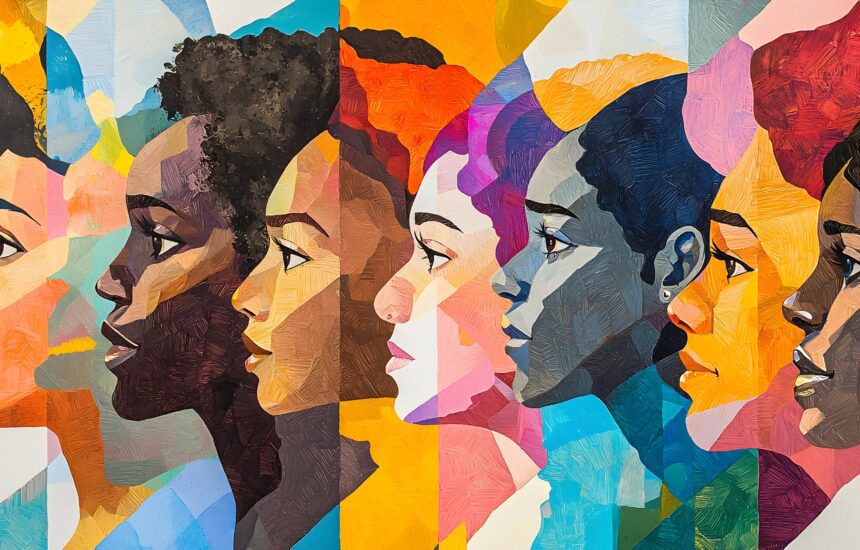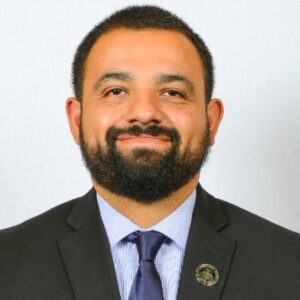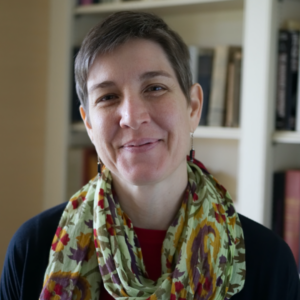Intersectionality and Diversification of the U.S. Teacher Workforce


This post is part of a blog series focused on creating welcoming pathways for refugee/(im)migrant educators in the U.S.
“The reality is that people are moving. More people are coming from different countries. It’s very, very important to know the background for all those families [and] the kids, and that way the kids can feel supported…
I can see the faces in the classroom when the kids can speak Spanish with me, and I can see in their faces, ‘Oh, there’s something there for me.’ Like they can connect. Kids learn fast, and I think it’s very important teachers need to support the diversity in the classroom, the different cultures, and don’t judge the book by the cover because we don’t know the reality of all those kids and their families.”
-Pathways to Teaching Project Fellow and aspiring U.S. classroom teacher from Mexico
Imagine what could happen if we supported a more representative and diverse teaching workforce that mirrored the multiplicity of cultures, languages, and lived experiences students and families bring to our schools across the U.S.
What might happen if more students were able to see “something there” for themselves in each school and in each classroom, if they could connect more fully with the teachers, staff, and administrators in their schools?
Diversity and inclusion are not just checkboxes limited to race. The complexity of human experience and the vibrance of humanity’s diversity is the fabric of U.S. society.
Continuing to rely, primarily, on archaic means of teacher preparation, such as college-based programming, that fail to take into consideration prior teaching and life experience of transnational educators and that assume monolithic (English) language and U.S.-based pedagogical and cultural experiences, prevents aspiring educators with refugee and (im)migrant backgrounds from pursuing education careers, and it ultimately harms students. This system creates unwelcoming and “unbelonging” pathways to education careers in the U.S.
These systems, along with accompanying assumptions around digital literacy and fluency, the validity of standardized testing as a key licensure requirement, and other factors create barriers to re/joining education careers after migration or resettlement and perpetuates misalignment between student and community demographics.
Innovative solutions can produce a reimagined pipeline for education careers that builds upon the strengths of a more culturally, linguistically, and intersectionally diverse population of transnational educators.
With the progression of DEI (Diversity, Equity, and Inclusion) content, concepts, and efforts from scholars and practitioners across the U.S. and around the world, the concept of Intersectionality was coined by Dr. Kimberle Crenshaw (watch her TedTalk here or read an interview here) as a critical Black feminist framework. The concept draws attention to how different social identities interact and overlap to create inequities within the lived experiences of people who are actively and structurally marginalized by existing systems, including the education system.
Social identities include race, gender, class, sexuality, dis/ability, nationality, and citizenship statuses, among a plethora of other markers. Intersectionality argues that individuals’ experiences cannot be understood by separating aspects of one’s identity, as these identities intersect to produce compounded, simultaneous experiences of oppression. As Audre Lorde (1982) put it, “There is no such thing as a single-issue struggle because we do not live single-issue lives.” This framework is foundational for understanding and analyzing complex social issues, particularly around how systems of power and privilege operate together to shape lived experiences and systems.
Diversity efforts in institutions and workplaces have chiefly focused on race, gender, and multicultural ethnic backgrounds. Optically, this is powerful. It presents a compelling image, a representation, of inclusive spaces and spotlights initiatives that build these inclusive spaces.
However, many of these efforts fail to move from optics to transformative practices that challenge existing structures of power and privilege that maintain inequalities and inequities.
Diversity efforts can become symbols of tokenization that keep many people on the margins of these “inclusive” spaces and, thus, further exacerbate oppressive lived experiences within institutions.
As the optics of race and gender continue playing a role in representation efforts to diversify workforces, diversification through intersectionality can be beneficial in further expanding strength-based community cultural wealth such as social, linguistic, and navigational capital (Yosso, 2005) that organizations and institutions may not be tapping into.
Diversification must go beyond numerical representation and exert pressure to dismantle institutional and societal practices that perpetuate any demographic hierarchy. Ultimately, when we think of diversity, we need to consider whether we are actually expanding this definition to meet community needs and create welcome, inclusion, and belonging for all community members.
In the fall of 2023, with support from the New Schools Venture Fund, the Center for Professional Learning at Childhood Education International initiated a body of work aimed at both diversifying the teacher workforce and addressing teacher shortages (NCES, 2023; UNESCO, 2024).
The Pathways to Teaching Project (PTP) for individuals of refugee and (im)migrant backgrounds is built on recognition of the fact that the unique lived experiences and intersectional identities of refugees and (im)migrants bring much-needed cultural and linguistic diversity into U.S. schools and classrooms. PTP centers transnational educators’ perspectives, expertise, and resources to enrich our schools.
In the U.S., more than 3.1 million refugees have been resettled since 1980 (MPI, 2023). More than 26% of the U.S. student population is now of refugee or (im)migrant backgrounds or the child of a foreign-born parent (Sugarman, 2023), and nearly 500 languages are spoken in the homes of multilingual families across the U.S. (OELA, 2023a). This increased diversity builds on already diverse populations and is not reflected in the U.S. teacher workforce, which remains 80-85% white (NCES, 2023; Schaeffer, 2021) and monolingual English-speaking, with only 13% of K-12 teachers identifying as bilingual or multilingual (Williams, 2023).
Research indicates that recruiting and retaining well-prepared teachers who reflect the intersectional diversity in their communities can contribute to more equitable experiences and outcomes for learners (e.g., IES, n.d.; Lindsay et al., 2022; Miller, 2018; Yip & Saito, 2023; UNESCO, 2024).
Thus, building on the existing, and largely untapped, talent in U.S. communities, PTP helps people (re)join their chosen profession as educators — and thus better integrate, achieve economic self-sufficiency, and build meaningful and deep connections in the U.S. — while also addressing the learning and well-being outcomes of intersectionally diverse preK-12 learners.
Through PTP, schools have an opportunity to not only reflect the communities they serve but also to challenge systemic inequities.
Intersectional diversity is a strength of the PTP community and of the U.S. education system that can be leveraged to foster belonging, support transformation, and overcome oppressive policies and practices.
Welcoming community cultural wealth into schools and classrooms through teacher diversification efforts that take a decidedly assets-based approach is essential to building a culturally and linguistically relevant and sustaining education system that builds a brighter future in the U.S. and for the world.
Intersectional diversification of the U.S. educator workforce is a collective effort we can and must embrace to create classrooms, schools and communities where all children – and educators – thrive.
“I remember one of the [PTP] speakers said ‘I carry a drum from my country; I carry a map of my country; I wear an attire that was made in my country.’ Those make wonderful, remarkable connections to kids… They look at you and see themselves in what you wear or what you say.”
– Pathways to Teaching Project Fellow, paraeducator, and aspiring U.S. classroom teacher from Liberia
 Dr. Mario Echeverria, Director of Talent & Leadership Development for the KIPP Foundation
Dr. Mario Echeverria, Director of Talent & Leadership Development for the KIPP FoundationDr. Mario Echeverria (he/him/él) was born in El Salvador and immigrated to Los Angeles in 1985. He has more than 21 years of experience of working in the juvenile incarceration system, mental health, education, and nonprofit/for-profit sector.
Currently, Mario is Director, Talent and Leadership Development for the KIPP Foundation, focusing on building principal pipelines. Throughout his career, he has founded his own middle school through the KIPP network, started his own consulting company focusing on leadership coaching, and completed his Ph.D. in Education for Social Justice. His dissertation and research focuses on Latinx educators, supporting their retention, progression, and deconstructing their identities to support being their most authentic selves.
Most recently, Mario worked as the Director of Engagements for the Equity Lab, which focuses on organizational and leadership change through Race, Equity, Diversity, and Inclusion frameworks, content, and co-constructed experiential learning opportunities. Mario is currently working on research on anti-racism pedagogy, Latino male educator hiring, retention, and promotion strategies, and identity-based coaching focused on liberation. In addition, Mario teaches courses on culturally relevant and responsive pedagogy, principalship courses on identity and advocacy, and teacher prep on creation of culture in classrooms.
 Julie Kasper, Director of Teacher Learning & Leadership
Julie Kasper, Director of Teacher Learning & LeadershipJulie Kasper is Director of Teacher Learning & Leadership at Childhood Education International’s Center for Professional Learning.
She has a master’s in TESOL from Teachers College, Columbia University and is a National Board Certified Teacher in English as a New Language. She taught in K-12 and adult education classrooms for more than 16 years, the majority of that time in secondary ESL classrooms in New York City and Tucson, Arizona.
Julie served as Refugee School Coordinator for Tucson from 2014-2018 and joined the Center for Professional Learning (formerly the Center for Learning in Practice) in the summer of 2018 to lead the Refugee Educator Academy initiative. Julie is also currently pursuing her doctorate in Educational Leadership as a University Fellow at the University of Arizona.